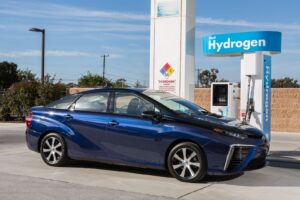ButSpeak.com
News which Matters.

Ukrainian forces ingeniously used a Toyota Mirai’s hydrogen tank to create a powerful remote-operated bomb, marking the world’s first documented hydrogen bomb deployed in combat.
In a striking display of ingenuity, Ukrainian fighters have reportedly deployed what could be considered the world’s first hydrogen bomb, fashioned from the fuel tank of a Toyota Mirai hydrogen car. This unconventional weapon was used during a counteroffensive in Vovchansk, northern Ukraine, as part of ongoing efforts to repel Russian forces.
According to reports from Euromaidan Press, a pro-Ukrainian outlet, the makeshift bomb was a response to the Russian military’s retreat to a fortified position in an aggregate plant north of the town. Ukrainian fighters, constrained by reduced foreign military aid and unable to rely on airstrikes or conventional drone attacks, turned to alternative methods to breach the Russian defenses.
The Toyota Mirai, a hydrogen-powered vehicle, became an unlikely tool of war. Its fuel tank, designed to hold hydrogen at a staggering 10,000 psi, was repurposed as a key component in a massive explosive device. The tank’s hydrogen, with an enormous potential energy of 33.6 Wh/kg, was combined with additional plastic explosives to create a bomb with the destructive power of approximately 357 pounds of TNT.
The bomb was mounted on a remotely operated vehicle, which navigated through a partially destroyed bridge, concealed by a nearby stand of trees. It successfully reached the eastern building within the Russian-held complex before being detonated. The resulting explosion sent a mushroom cloud into the sky, followed by a significant fire, believed to have hit Russian ammunition storage.
The blast severely compromised the Russian fortifications, prompting them to reinforce the weakened position. However, this reaction reportedly created vulnerabilities in other areas, allowing Ukrainian resistance fighters to gain ground and threaten the supply lines supporting the Russian forces in the aggregate plant.
While the battle for Vovchansk continues, this innovative use of a Toyota Mirai highlights the resourcefulness of Ukrainian forces. In a war where conventional resources are often scarce, the ability to adapt and repurpose available materials has become a critical aspect of the conflict. The deployment of this hydrogen bomb, built from an electrified vehicle, underscores the lengths to which these fighters will go to defend their territory and push back against the Russian invasion.